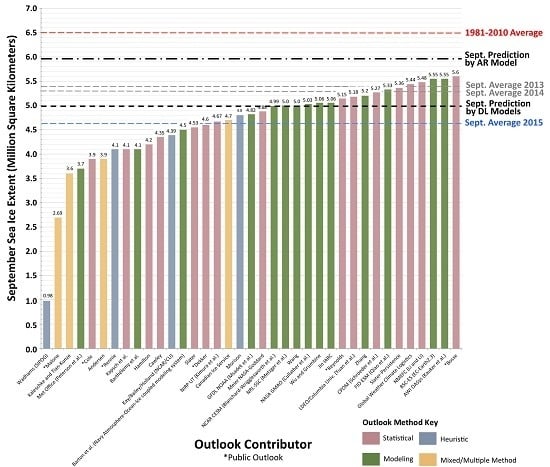Comparison of Different Machine Learning Approaches for Monthly Satellite-Based Soil Moisture Downscaling over Northeast China
Abstract
:1. Introduction
2. Study Area and Data Resources
2.1. Study Area
2.2. Data Resources
3. Methods
3.1. Downscaling Process
- (1)
- We get the diurnal temperature fluctuation (LSTDF) by LSTNIGHT from LSTDAY. Then, all nine independent variables are re-projected to the Albers Conical Equal Area projection, WGS 1984 datum and resampled to 1-km as input parameters.
- (2)
- MODIS 44W 250-m land–water mask data are utilized to remove water body area from both 25-km and 1-km data for the sake of excluding unnecessary influences of water areas.
- (3)
- Multiple correlations and fitting models are established through the CART, KNN, BAYE, and RF algorithms among the independent variables and ESA CCI SM on the 25-km scale.
- (4)
- Based on the models already built by the training sample data, 1-km spatial resolution parameters are input as predicting data to obtain downscaled fine-resolution SM data.
3.2. Brief Introduction of Machine Learning Regression Algorithms
- (1)
- The essence of CART is to divide the feature space into two parts, namely to generate a binary decision tree [60]. CART can split both nominal attributes and continuous attributes. CART produces a series of cut points to make sure that samples within a subgroup have maximal homogeneity and samples in different subgroups have maximal diversity. The cut points are called nodes and the terminal nodes are called leaf nodes, which divide the dataset to a final sub-tree. Moreover, the relationship between the independent variables and dependent variables within a sub-tree can be explained in a same model [61].
- (2)
- KNN is a simple and efficient machine learning algorithm. If in the feature space the k-most-adjacent samples belong to a certain group, then the nonclassified sample also belongs to this group, and has the characteristics of the group. In determining the classification, the KNN method decides the category of the sample to be divided merely according to the nearest one or few samples [62].
- (3)
- There are two main steps in a BAYE model. First, training data are utilized to obtain the likelihood function. We get the posterior distribution by a combination of the likelihood function and a prior distribution. After that, for a new test dataset, a weighted integral is computed in the whole parameter space by using the previously obtained posterior as weights, yielding a predictive data distribution [63].
- (4)
- RF is an ensemble learning algorithm that uses multiple decision trees to obtain better prediction performance. It was first developed by Leo Breiman and Adele Cutler [64]. Its superiority is embodied in relative fast training speed, and the performance optimization process improves the accuracy of the RF model [65]. The RF regression process can be divided into three parts. First, several sub-sets are randomly drawn from the original datasets with replacement. The elements of different sub-datasets can be repeated, as can elements in the same subset. Second, every sub-decision tree is constructed by a certain sub-dataset and then outputs a regression result. Third, for classification problems, the final output is the mode of the classes of all the individual trees; for regression problems, the predicted results are obtained by averaging the prediction of individual trees [66].
4. Results and Analysis
4.1. Performance of Different Algorithms
4.2. Downscaled Soil Moisture
4.3. Validation for In-Situ Soil Moisture
4.4. Comparison with Precipitation Data
5. Discussion
6. Conclusions
Acknowledgments
Author Contributions
Conflicts of Interest
References
- Entekhabi, D.; Rodriguez-Iturbe, I.; Bras, R.L. Variability in large-scale water balance with land surface-atmosphere interaction. J. Clim. 1992, 5, 798–813. [Google Scholar] [CrossRef]
- Drusch, M. Initializing numerical weather prediction models with satellite-derived surface soil moisture: Data assimilation experiments with ECMWF’s Integrated Forecast System and the TMI soil moisture data set. J. Geophys. Res. Atmos. 2007, 112. [Google Scholar] [CrossRef]
- Seneviratne, S.I.; Corti, T.; Davin, E.L.; Hirschi, M.; Jaeger, E.B.; Lehner, I.; Orlowsky, B.; Teuling, A.J. Investigating soil moisture—Climate interactions in a changing climate: A review. Earth Sci. Rev. 2010, 99, 125–161. [Google Scholar] [CrossRef]
- Seneviratne, S.I.; Lüthi, D.; Litschi, M.; Schär, C. Land-atmosphere coupling and climate change in Europe. Nature 2006, 443, 205–209. [Google Scholar] [CrossRef] [PubMed]
- Engman, E.T. Applications of microwave remote sensing of soil moisture for water resources and agriculture. Remote Sens. Environ. 1991, 35, 213–226. [Google Scholar] [CrossRef]
- Denmead, O.; Shaw, R.H. Availability of soil water to plants as affected by soil moisture content and meteorological conditions. Agron. J. 1962, 54, 385–390. [Google Scholar] [CrossRef]
- Jiang, Y.; Weng, Q. Estimation of hourly and daily evapotranspiration and soil moisture using downscaled LST over various urban surfaces. GISci. Remote Sens. 2017, 54, 95–117. [Google Scholar] [CrossRef]
- Dorigo, W.; Wagner, W.; Hohensinn, R.; Hahn, S.; Paulik, C.; Xaver, A.; Gruber, A.; Drusch, M.; Mecklenburg, S. The International Soil Moisture Network: A data hosting facility for global in situ soil moisture measurements. Hydrol. Earth Syst. Sci. 2011, 15, 1675–1698. [Google Scholar] [CrossRef]
- Robock, A.; Vinnikov, K.Y.; Srinivasan, G.; Entin, J.K.; Hollinger, S.E.; Speranskaya, N.A.; Liu, S.; Namkhai, A. The Global Soil Moisture Data Bank. Bull. Am. Meteorol. Soc. 2000, 81, 1281–1300. [Google Scholar] [CrossRef]
- Bitar, A.A.; Leroux, D.; Kerr, Y.H.; Merlin, O.; Richaume, P.; Sahoo, A.; Wood, E.F. Evaluation of SMOS Soil Moisture Products Over Continental U.S. Using the SCAN/SNOTEL Network. IEEE Trans. Geosci. Remote Sens. 2012, 50, 1572–1586. [Google Scholar] [CrossRef] [Green Version]
- Xu, B.; Li, J. A methodology to estimate representativeness of LAI station observation for validation: A case study with Chinese Ecosystem Research Network (CERN) in situ data. In Proceedings of the SPIE Asia Pacific Remote Sensing, Beijing, China, 27–31 October 2014. [Google Scholar]
- Paulik, C.; Dorigo, W.; Wagner, W.; Kidd, R. Validation of the ASCAT Soil Water Index using in situ data from the International Soil Moisture Network. Int. J. Appl. Earth Obs. Geoinf. 2014, 30, 1–8. [Google Scholar] [CrossRef]
- Murray, S.J.; Foster, P.N.; Prentice, I.C. Evaluation of global continental hydrology as simulated by the Land-surface processes and exchanges dynamic global vegetation model. Hydrol. Earth Syst. Sci. 2011, 15, 91–105. [Google Scholar] [CrossRef]
- Fu, B.; Li, S.; Yu, X.; Yang, P.; Yu, G.; Feng, R.; Zhuang, X. Chinese ecosystem research network: Progress and perspectives. Ecol. Complex. 2010, 7, 225–233. [Google Scholar] [CrossRef]
- Dorigo, W.; Xaver, A.; Vreugdenhil, M.; Gruber, A.; Hegyiová, A.; Sanchis-Dufau, A.; Zamojski, D.; Cordes, C.; Wagner, W.; Drusch, M.; et al. Global automated quality control of in situ soil moisture data from the International Soil Moisture Network. Vadose Zone J. 2013, 12. [Google Scholar] [CrossRef]
- Albergel, C.; de Rosnay, P.; Gruhier, C.; Muñoz-Sabater, J.; Hasenauer, S.; Isaksen, L.; Kerr, Y.; Wagner, W. Evaluation of remotely sensed and modelled soil moisture products using global ground-based in situ observations. Remote Sens. Environ. 2012, 118, 215–226. [Google Scholar] [CrossRef]
- Dorigo, W.; Oevelen, P.; Wagner, W.; Drusch, M.; Mecklenburg, S.; Robock, A.; Jackson, T. A new international network for in situ soil moisture data. Eos Trans. Am. Geophys. Union 2011, 92, 141–142. [Google Scholar] [CrossRef]
- Gruber, A.; Dorigo, W.; Zwieback, S.; Xaver, A.; Wagner, W. Characterizing coarse-scale representativeness of in situ soil moisture measurements from the International Soil Moisture Network. Vadose Zone J. 2013, 12. [Google Scholar] [CrossRef]
- Wang, Y.; Shao, M.A.; Liu, Z. Large-scale spatial variability of dried soil layers and related factors across the entire Loess Plateau of China. Geoderma 2010, 159, 99–108. [Google Scholar] [CrossRef]
- Feng, X.; Li, J.; Cheng, W.; Fu, B.; Wang, Y.; Lü, Y.; Shao, M. Evaluation of AMSR-E retrieval by detecting soil moisture decrease following massive dryland re-vegetation in the Loess Plateau, China. Remote Sens. Environ. 2017, 196, 253–264. [Google Scholar] [CrossRef]
- Lobl, E. Joint advanced microwave scanning radiometer (AMSR) science team meeting. Earth Obs. 2001, 13, 3–9. [Google Scholar]
- Li, L.; Njoku, E.G.; Im, E.; Chang, P.S.; Germain, K.S. A preliminary survey of radio-frequency interference over the US in Aqua AMSR-E data. IEEE Trans. Geosci. Remote Sens. 2004, 42, 380–390. [Google Scholar] [CrossRef]
- Kerr, Y.H.; Waldteufel, P.; Wigneron, J.-P.; Martinuzzi, J.; Font, J.; Berger, M. Soil moisture retrieval from space: The Soil Moisture and Ocean Salinity (SMOS) mission. IEEE Trans. Geosci. Remote Sens. 2001, 39, 1729–1735. [Google Scholar] [CrossRef]
- Gaiser, P.W.; St. Germain, K.M.; Twarog, E.M.; Poe, G.A.; Purdy, W.; Richardson, D.; Grossman, W.; Jones, W.L.; Spencer, D.; Golba, G.; et al. The WindSat spaceborne polarimetric microwave radiometer: Sensor description and early orbit performance. IEEE Trans. Geosci. Remote Sens. 2004, 42, 2347–2361. [Google Scholar] [CrossRef]
- Moran, M.S.; Peters-Lidard, C.D.; Watts, J.M.; McElroy, S. Estimating soil moisture at the watershed scale with satellite-based radar and land surface models. Can. J. Remote Sens. 2004, 30, 805–826. [Google Scholar] [CrossRef]
- Wagner, W.; Lemoine, G.; Rott, H. A method for estimating soil moisture from ERS scatterometer and soil data. Remote Sens. Environ. 1999, 70, 191–207. [Google Scholar] [CrossRef]
- Paloscia, S.; Pettinato, S.; Santi, E.; Notarnicola, C.; Pasolli, L.; Reppucci, A. Soil moisture mapping using Sentinel-1 images: Algorithm and preliminary validation. Remote Sens. Environ. 2013, 134, 234–248. [Google Scholar] [CrossRef]
- Entekhabi, D.; Njoku, E.G.; O’Neill, P.E.; Kellogg, K.H.; Crow, W.T.; Edelstein, W.N.; Entin, J.K.; Goodman, S.D.; Jackson, T.J.; Johnson, J.; et al. The soil moisture active passive (SMAP) mission. Proc. IEEE 2010, 98, 704–716. [Google Scholar] [CrossRef]
- Dorigo, W.; Gruber, A.; de Jeu, R.; Wagner, W.; Stacke, T.; Loew, A.; Albergel, C.; Brocca, L.; Chung, D.; Parinussa, R.; et al. Evaluation of the ESA CCI soil moisture product using ground-based observations. Remote Sens. Environ. 2015, 162, 380–395. [Google Scholar] [CrossRef]
- Shuttleworth, J.; Rosolem, R.; Zreda, M.; Franz, T. The COsmic-ray Soil Moisture Interaction Code (COSMIC) for use in data assimilation. Hydrol. Earth Syst. Sci. 2013, 17, 3205–3217. [Google Scholar] [CrossRef]
- Djamai, N.; Magagi, R.; Goïta, K.; Merlin, O.; Kerr, Y.; Roy, A. A combination of DISPATCH downscaling algorithm with CLASS land surface scheme for soil moisture estimation at fine scale during cloudy days. Remote Sens. Environ. 2016, 184, 1–14. [Google Scholar] [CrossRef]
- Mallick, K.; Bhattacharya, B.K.; Patel, N. Estimating volumetric surface moisture content for cropped soils using a soil wetness index based on surface temperature and NDVI. Agric. For. Meteorol. 2009, 149, 1327–1342. [Google Scholar] [CrossRef]
- Sandholt, I.; Rasmussen, K.; Andersen, J. A simple interpretation of the surface temperature/vegetation index space for assessment of surface moisture status. Remote Sens. Environ. 2002, 79, 213–224. [Google Scholar] [CrossRef]
- Fang, B.; Lakshmi, V.; Bindlish, R.; Jackson, T.J.; Cosh, M.; Basara, J. Passive microwave soil moisture downscaling using vegetation index and skin surface temperature. Vadose Zone J. 2013, 12. [Google Scholar] [CrossRef]
- Piles, M.; Camps, A.; Vall-Llossera, M.; Corbella, I.; Panciera, R.; Rudiger, C.; Kerr, Y.H.; Walker, J. Downscaling SMOS-derived soil moisture using MODIS visible/infrared data. IEEE Trans. Geosci. Remote Sens. 2011, 49, 3156–3166. [Google Scholar] [CrossRef]
- Justice, C.O.; Vermote, E.; Townshend, J.R.G.; Defries, R.; Roy, D.P.; Hall, D.K.; Salomonson, V.V.; Privette, J.L.; Riggs, G.; Strahler, A.; et al. The Moderate Resolution Imaging Spectroradiometer (MODIS): Land remote sensing for global change research. IEEE Trans. Geosci. Remote Sens. 1998, 36, 1228–1249. [Google Scholar] [CrossRef]
- Srivastava, P.K.; Han, D.; Ramirez, M.R.; Islam, T. Machine Learning Techniques for Downscaling SMOS Satellite Soil Moisture Using MODIS Land Surface Temperature for Hydrological Application. Water Resour. Manag. 2013, 27, 3127–3144. [Google Scholar] [CrossRef]
- Peng, J.; Loew, A.; Zhang, S.; Wang, J.; Niesel, J. Spatial downscaling of satellite soil moisture data using a vegetation temperature condition index. IEEE Trans. Geosci. Remote Sens. 2016, 54, 558–566. [Google Scholar] [CrossRef]
- Jing, W.; Yang, Y.; Yue, X.; Zhao, X. A Comparison of Different Regression Algorithms for Downscaling Monthly Satellite-Based Precipitation over North China. Remote Sens. 2016, 8, 835. [Google Scholar] [CrossRef]
- Huete, A.R. A soil-adjusted vegetation index (SAVI). Remote Sens. Environ. 1988, 25, 295–309. [Google Scholar] [CrossRef]
- Merlin, O.; Walker, J.P.; Chehbouni, A.; Kerr, Y. Towards deterministic downscaling of SMOS soil moisture using MODIS derived soil evaporative efficiency. Remote Sens. Environ. 2008, 112, 3935–3946. [Google Scholar] [CrossRef] [Green Version]
- Merlin, O.; Al Bitar, A.; Walker, J.P.; Kerr, Y. An improved algorithm for disaggregating microwave-derived soil moisture based on red, near-infrared and thermal-infrared data. Remote Sens. Environ. 2010, 114, 2305–2316. [Google Scholar] [CrossRef] [Green Version]
- Moore, I.; Burch, G.; Mackenzie, D. Topographic effects on the distribution of surface soil water and the location of ephemeral gullies. Trans. ASAE 1988, 31, 1098–1107. [Google Scholar] [CrossRef]
- Samworth, R.J. Optimal weighted nearest neighbour classifiers. Ann. Stat. 2012, 40, 2733–2763. [Google Scholar] [CrossRef]
- Zellner, A. On assessing prior distributions and Bayesian regression analysis with G-prior distributions. Bayesian Inference Decis. Tech. 1986, 6, 233–243. [Google Scholar]
- Breiman, L.I.; Friedman, J.H.; Olshen, R.A.; Stone, C.J. Classification and Regression Trees (CART). Biometrics 1984, 40, 358. [Google Scholar]
- Svetnik, V.; Liaw, A.; Tong, C.; Culberson, J.C.; Sheridan, R.P.; Feuston, B.P. Random Forest: A Classification and Regression Tool for Compound Classification and QSAR Modeling. J. Chem. Inf. Comput. Sci. 2003, 43, 1947–1958. [Google Scholar] [CrossRef] [PubMed]
- Carlson, T.N.; Gillies, R.R.; Perry, E.M. A method to make use of thermal infrared temperature and NDVI measurements to infer surface soil water content and fractional vegetation cover. Remote Sens. Rev. 1994, 9, 161–173. [Google Scholar] [CrossRef]
- Wei, S.U.; De-Yong, Y.U.; Sun, Z.P.; Zhan, J.G.; Liu, X.X.; Qian, L. Vegetation changes in the agricultural-pastoral areas of northern China from 2001 to 2013. J. Integr. Agric. 2016, 15, 1145–1156. [Google Scholar]
- Dai, Y.; Shangguan, W.; Duan, Q.; Liu, B.; Fu, S.; Niu, G. Development of a China Dataset of Soil Hydraulic Parameters Using Pedotransfer Functions for Land Surface Modeling. J. Hydrometeorol. 2013, 14, 869–887. [Google Scholar] [CrossRef]
- Shangguan, W.; Dai, Y.; Liu, B.; Zhu, A.; Duan, Q.; Wu, L.; Ji, D.; Ye, A.; Yuan, H.; Zhang, Q. A China data set of soil properties for land surface modeling. J. Adv. Model. Earth Syst. 2013, 5, 212–224. [Google Scholar] [CrossRef]
- Bontemps, S.; Defourny, P.; Radoux, J.; van Bogaert, E.; Lamarche, C.; Achard, F.; Mayaux, P.; Boettcher, M.; Brockmann, C.; Kirches, G. Consistent global land cover maps for climate modelling communities: Current achievements of the ESA’s land cover CCI. In Proceedings of the ESA Living Planet Symposium, Edimburgh, UK, 9–13 September 2013. [Google Scholar]
- Hollmann, R.; Merchant, C.J.; Saunders, R.; Downy, C.; Buchwitz, M.; Cazenave, A.; Chuvieco, E.; Defourny, P.; de Leeuw, G.; Forsberg, R.; et al. The ESA climate change initiative: Satellite data records for essential climate variables. Bull. Am. Meteorol. Soc. 2013, 94, 1541–1552. [Google Scholar] [CrossRef]
- McNally, A.; Shukla, S.; Arsenault, K.R.; Wang, S.; Peters-Lidard, C.D.; Verdin, J.P. Evaluating ESA CCI soil moisture in East Africa. Int. J. Appl. Earth Obs. Geoinf. 2016, 48, 96–109. [Google Scholar] [CrossRef]
- Justice, C.O.; Townshend, J.R.G.; Vermote, E.F.; Masuoka, E.; Wolfe, R.E.; Saleous, N.; Roy, D.P.; Morisette, J.T. An overview of MODIS Land data processing and product status. Remote Sens. Environ. 2002, 83, 3–15. [Google Scholar] [CrossRef]
- Rabus, B.; Eineder, M.; Roth, A.; Bamler, R. The shuttle radar topography mission—A new class of digital elevation models acquired by spaceborne radar. ISPRS J. Photogramm. Remote Sens. 2003, 57, 241–262. [Google Scholar] [CrossRef]
- Huffman, G.J.; Adler, R.F.; Bolvin, D.T.; Nelkin, E.J. The TRMM Multi-Satellite Precipitation Analysis (TMPA). J. Hydrometeorol. 2007, 90, 237–247. [Google Scholar]
- Western, A.; Grayson, R. Soil moisture and runoff processes at Tarrawarra. Spat. Patterns Catchment Hydrol. Obs. Model. 2000, 209–246. [Google Scholar]
- Western, A.W.; Grayson, R.B.; Blöschl, G. Scaling of soil moisture: A hydrologic perspective. Annu. Rev. Earth Planet. Sci. 2002, 8, 149–180. [Google Scholar] [CrossRef]
- Burrows, W.R.; Benjamin, M.; Beauchamp, S.; Lord, E.R.; McCollor, D.; Thomson, B. CART decision-tree statistical analysis and prediction of summer season maximum surface ozone for the Vancouver, Montreal, and Atlantic regions of Canada. J. Appl. Meteorol. 1995, 34, 1848–1862. [Google Scholar] [CrossRef]
- Westreich, D.; Lessler, J.; Funk, M.J. Propensity score estimation: Neural networks, support vector machines, decision trees (CART), and meta-classifiers as alternatives to logistic regression. J. Clin. Epidemiol. 2010, 63, 826–833. [Google Scholar] [CrossRef] [PubMed]
- Yu, C.; Ooi, B.C.; Tan, K.-L.; Jagadish, H. Indexing the distance: An efficient method to knn processing. In Proceedings of the 27th International Conference on Very Large Data Bases, Roma, Italy, 11–14 September 2001. [Google Scholar]
- Drummond, A.J.; Rambaut, A. BEAST: Bayesian evolutionary analysis by sampling trees. BMC Evol. Biol. 2007, 7, 214. [Google Scholar] [CrossRef] [PubMed] [Green Version]
- Breiman, L. Random forests. Mach. Learn. 2001, 45, 5–32. [Google Scholar] [CrossRef]
- Liaw, A.; Wiener, M. Classification and regression by randomForest. R News 2002, 2, 18–22. [Google Scholar]
- Pal, M. Random forest classifier for remote sensing classification. Int. J. Remote Sens. 2005, 26, 217–222. [Google Scholar] [CrossRef]
- Pedregosa, F.; Varoquaux, G.; Gramfort, A.; Michel, V.; Thirion, B.; Grisel, O.; Blondel, M.; Prettenhofer, P.; Weiss, R.; Dubourg, V.; et al. Scikit-learn: Machine learning in Python. J. Mach. Learn. Res. 2011, 12, 2825–2830. [Google Scholar]
- Abraham, A.; Pedregosa, F.; Eickenberg, M.; Gervais, P.; Mueller, A.; Kossaifi, J.; Gramfort, A.; Thirion, B.; Varoquaux, G. Machine learning for neuroimaging with scikit-learn. Front. Neuroinform. 2014, 8, 14. [Google Scholar] [CrossRef] [PubMed] [Green Version]
- Owe, M.; Van de Griend, A.A. Comparison of soil moisture penetration depths for several bare soils at two microwave frequencies and implications for remote sensing. Water Resour. Res. 1998, 34, 2319–2327. [Google Scholar] [CrossRef] [Green Version]
- Casa, R.; Castaldi, F.; Pascucci, S.; Palombo, A.; Pignatti, S. A comparison of sensor resolution and calibration strategies for soil texture estimation from hyperspectral remote sensing. Geoderma 2013, 197–198, 17–26. [Google Scholar] [CrossRef]
- Shangguan, W.; Dai, Y.; Liu, B.; Ye, A.; Yuan, H. A soil particle-size distribution dataset for regional land and climate modelling in China. Geoderma 2012, 171–172, 85–91. [Google Scholar] [CrossRef]
- Hohenegger, C.; Brockhaus, P.; Bretherton, C.S.; Schär, C. The soil moisture—Precipitation feedback in simulations with explicit and parameterized convection. J. Clim. 2009, 22, 5003–5020. [Google Scholar] [CrossRef]
- Wagner, W.; Scipal, K.; Pathe, C.; Gerten, D.; Lucht, W.; Rudolf, B. Evaluation of the agreement between the first global remotely sensed soil moisture data with model and precipitation data. J. Geophys. Res. Atmos. 2003, 108. [Google Scholar] [CrossRef]
- Sawut, M.; Ghulam, A.; Tiyip, T.; Zhang, Y.J.; Ding, J.L.; Zhang, F.; Maimaitiyiming, M. Estimating soil sand content using thermal infrared spectra in arid lands. Int. J. Appl. Earth Obs. Geoinf. 2014, 33, 203–210. [Google Scholar] [CrossRef]
- Hoai, N.D.; Udo, K.; Mano, A. Downscaling Global Weather Forecast Outputs Using ANN for Flood Prediction. J. Appl. Math. 2011, 2011, 223–236. [Google Scholar]
- Hsu, K.; Lin, X.; Gupta, H.V.; Sorooshian, S. Artificial Neural Network Modeling of the Rainfall-Runoff Process. Water Resour. Res. 2010, 31, 2517–2530. [Google Scholar] [CrossRef]
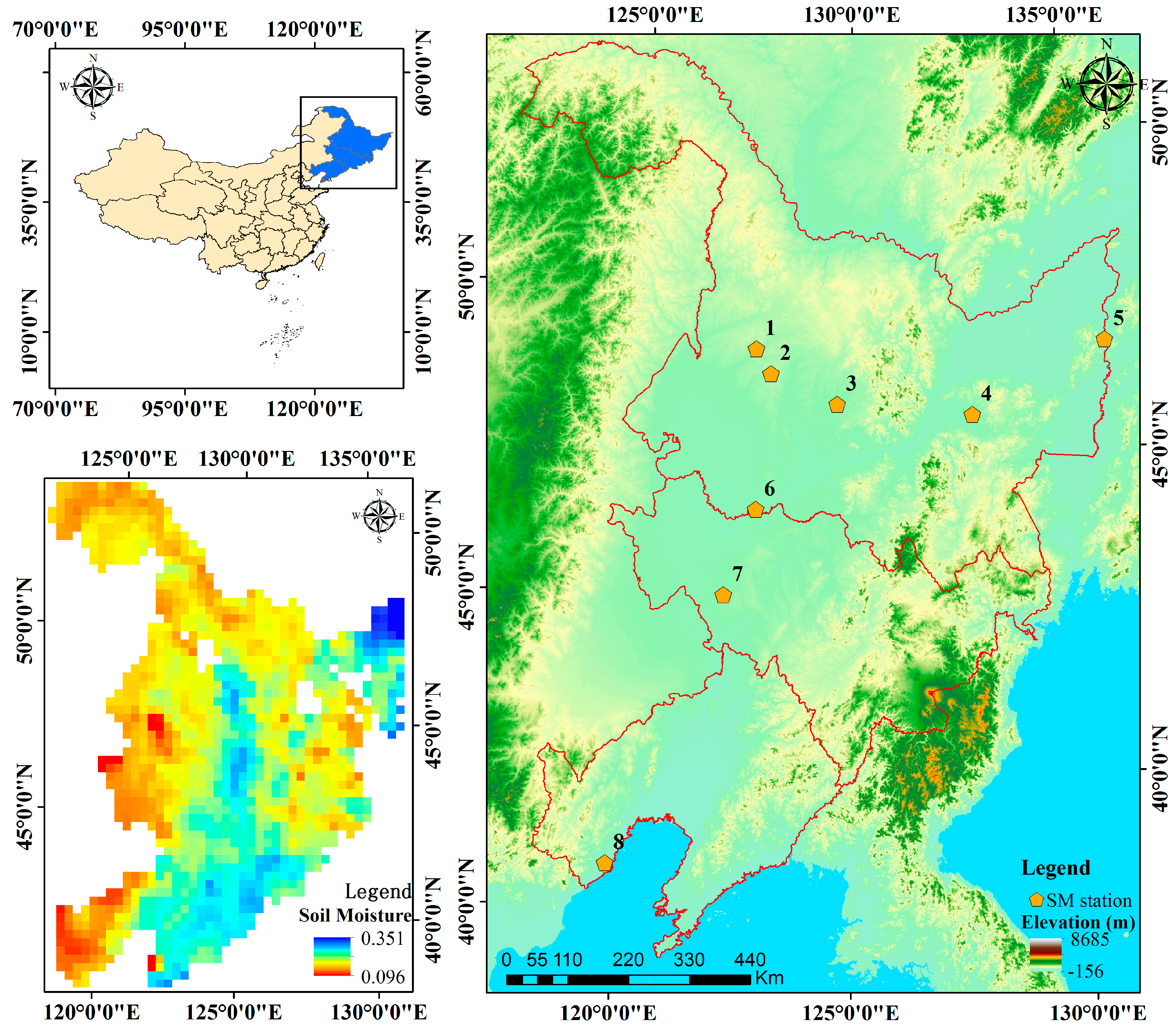
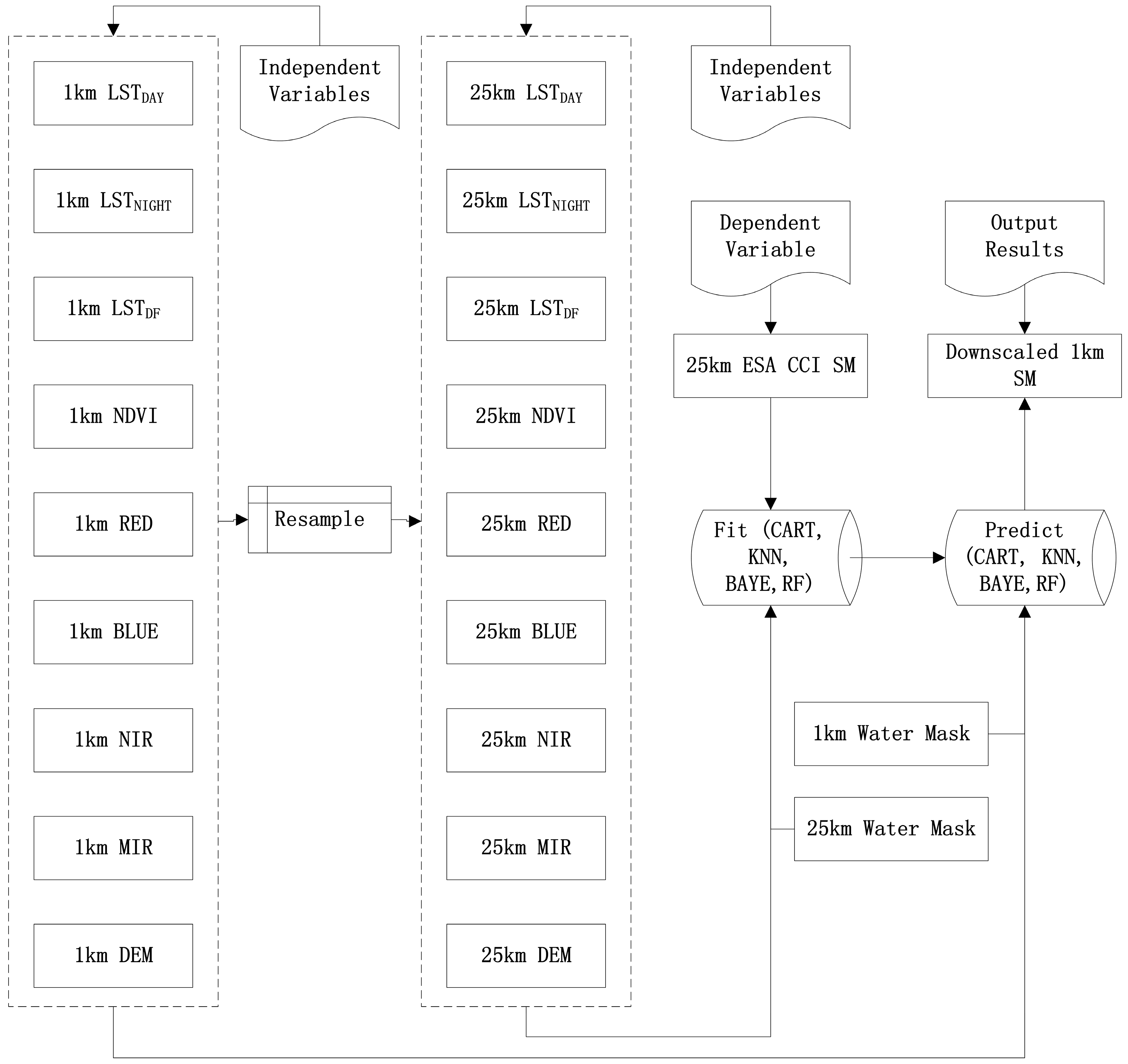



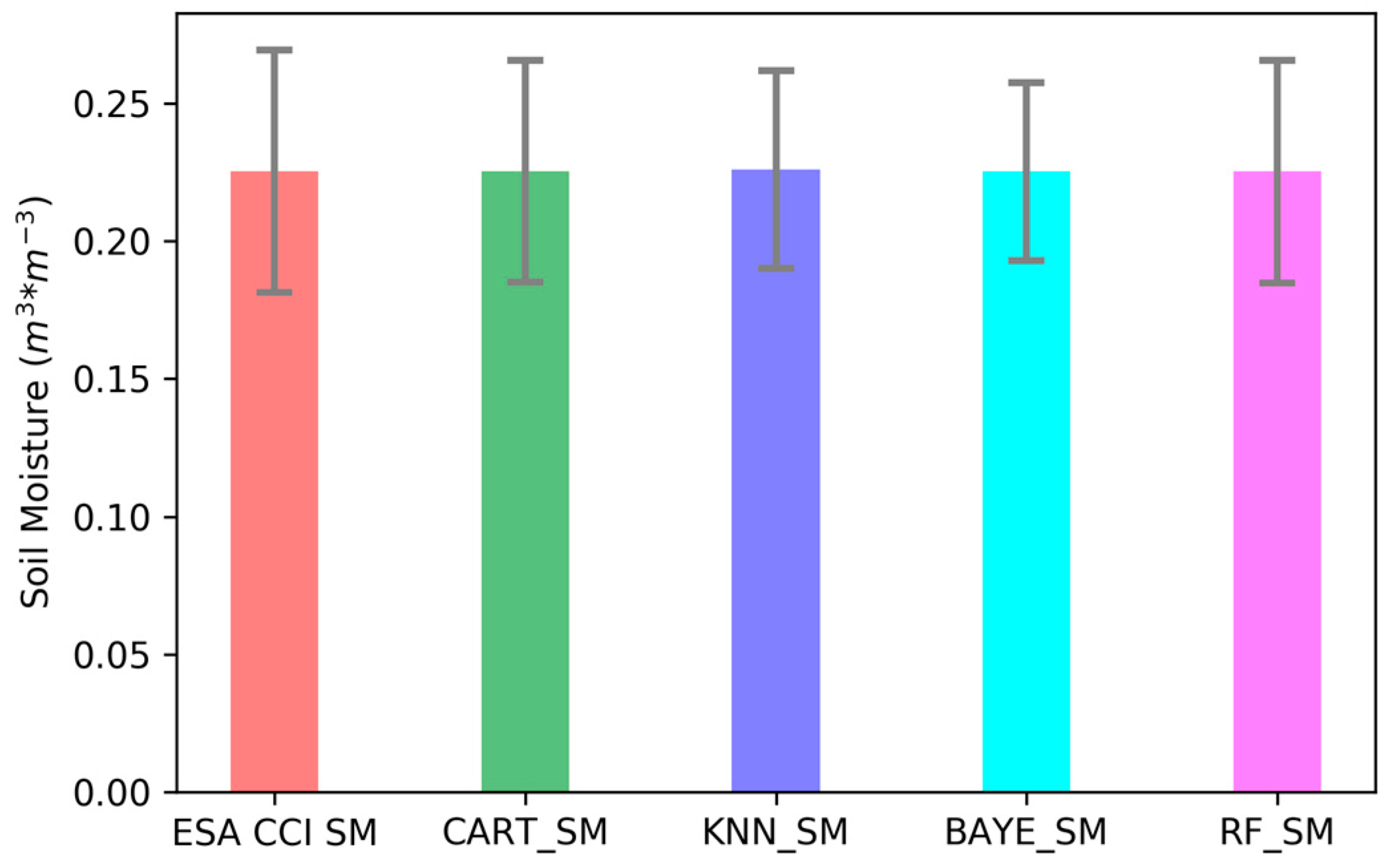
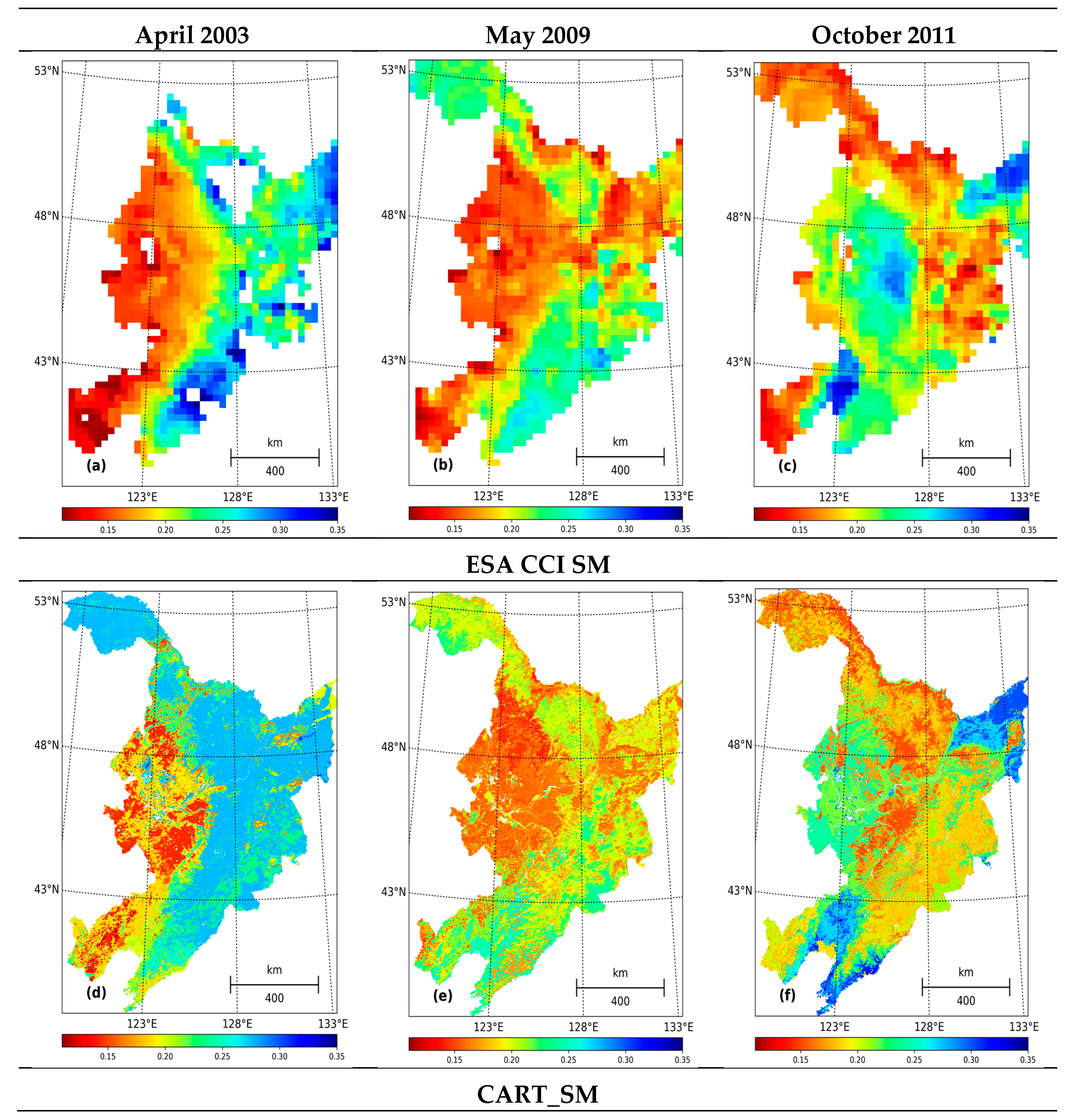
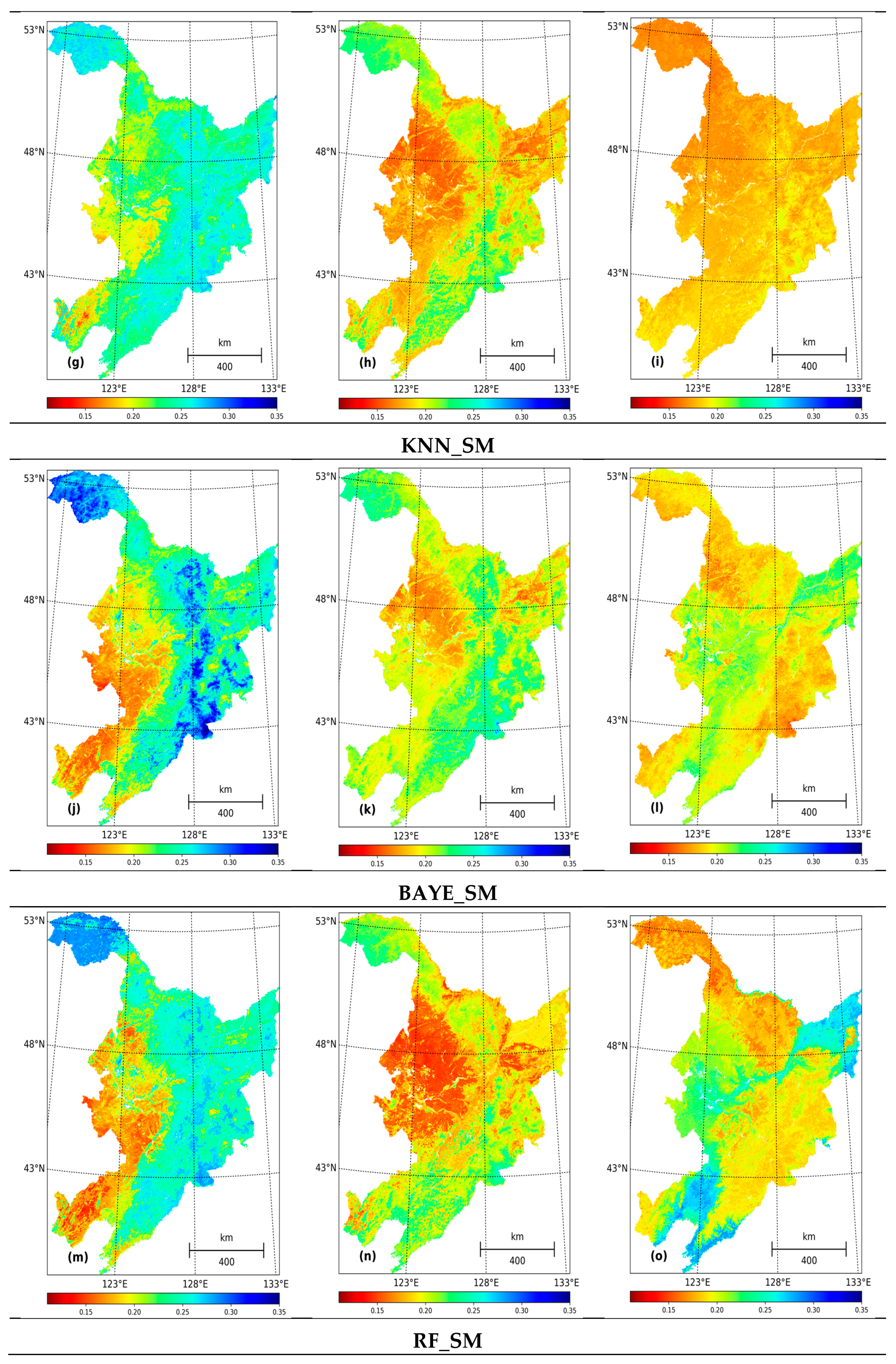


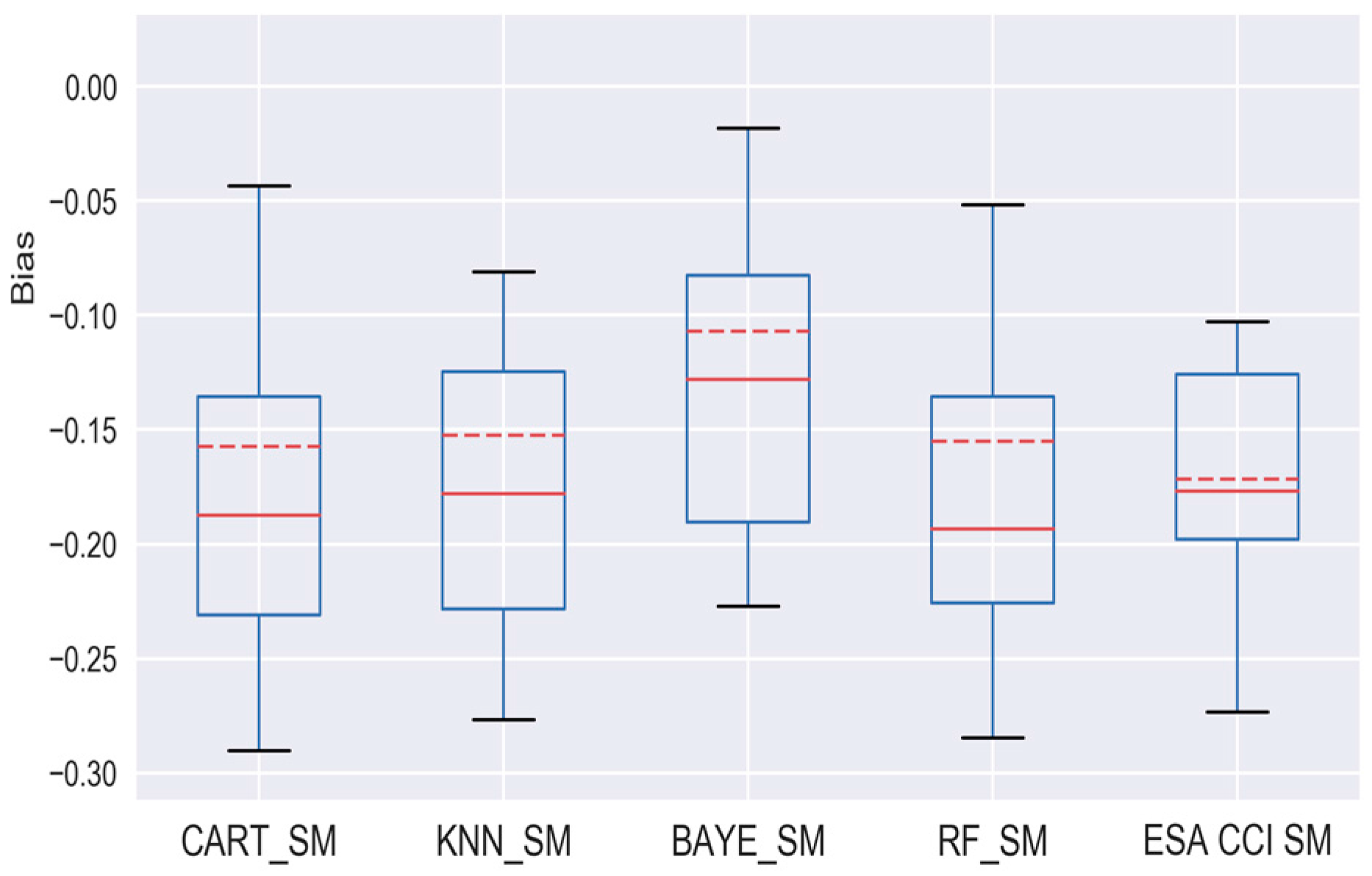
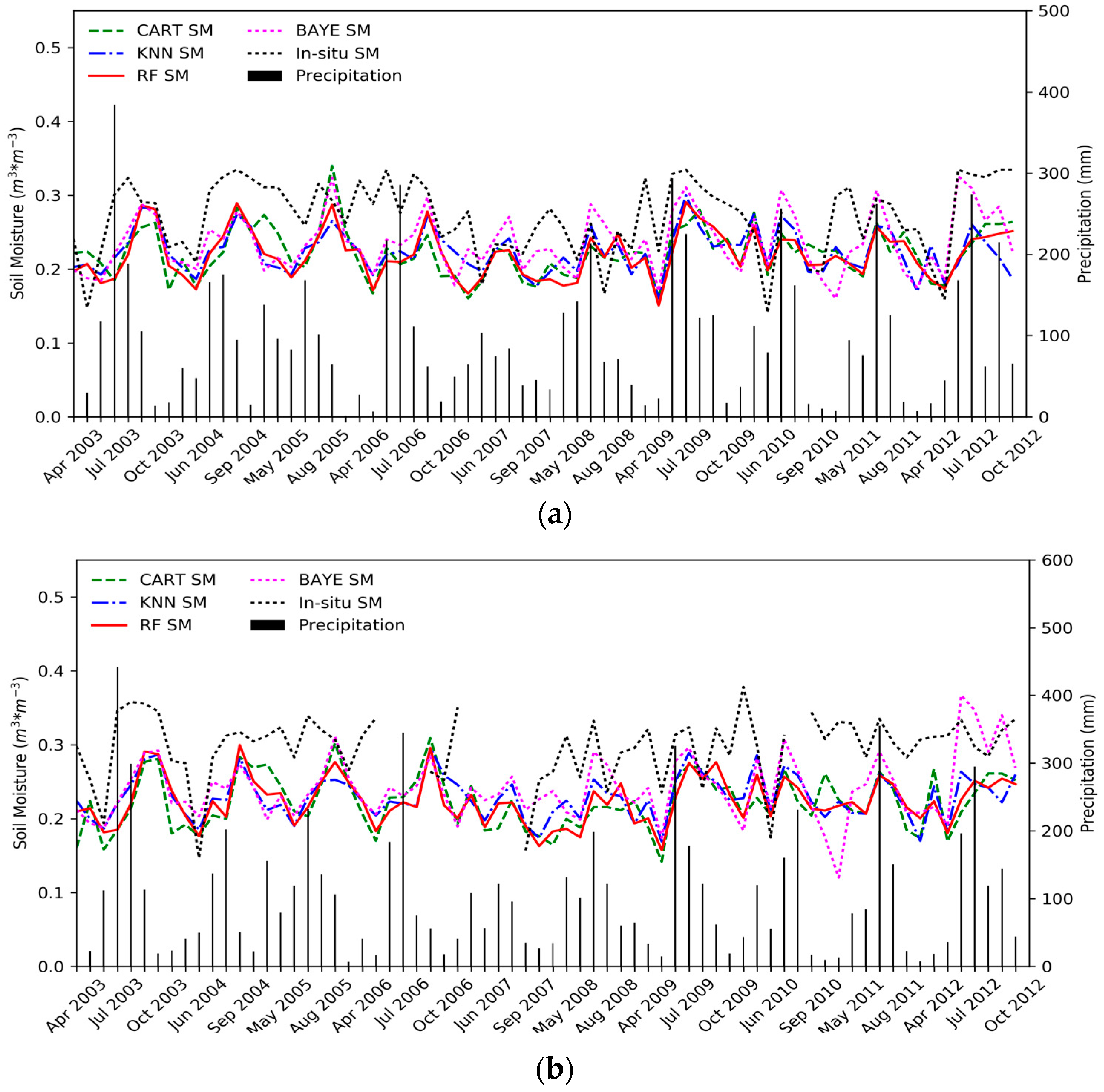

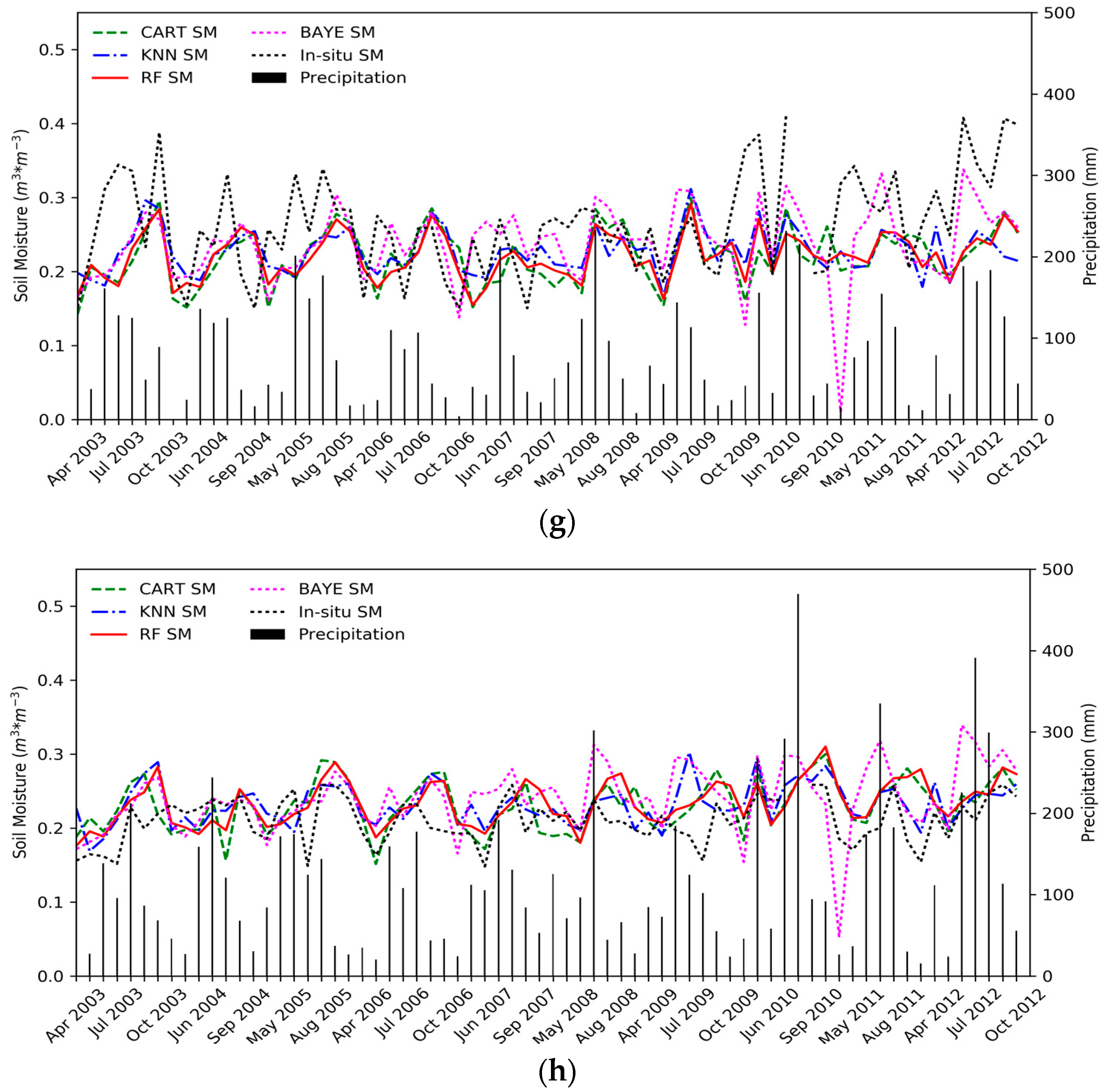
| Algorithm | Parameter Name | Parameter Meaning | Value Ranges |
|---|---|---|---|
| CART | MinSamplesLeaf | The minimum sample number to split internal node. (default = 2) | 1, 2, 3, 4, 5, 6, 7, 8, 9, 10 |
| KNN | n_neighbors | Used neighbor number. (default = 5) | 2, 5, 8, 11, 14, 17, 20, 23, 26, 29 |
| BAYE | n_iter | Maximal iteration times. (default = 300) | 100, 150, 200, 300, 350, 400, 450, 500, 550, 600 |
| RF | n_estimators | Trees in the forest. (default = 10) | 20, 40, 60, 80, 100, 120, 140, 160, 180, 200 |
| Month | Method | CART | KNN | BAYE | RF | Average |
|---|---|---|---|---|---|---|
| pril | Slope | 1 | 1.049 | 1.009 | 1.074 | 1.033 |
| Interception | 0 | −0.011 | −0.002 | −0.015 | −0.007 | |
| RMSE | 0.018 | 0.024 | 0.034 | 0.01 | 0.022 | |
| MAE | 0.012 | 0.018 | 0.026 | 0.007 | 0.016 | |
| R2 | 0.847 | 0.715 | 0.437 | 0.959 | 0.74 | |
| May | Slope | 1 | 1.041 | 1.005 | 1.059 | 1.026 |
| Interception | 0 | −0.009 | −0.001 | −0.012 | −0.001 | |
| RMSE | 0.017 | 0.022 | 0.029 | 0.009 | 0.019 | |
| MAE | 0.013 | 0.016 | 0.022 | 0.006 | 0.014 | |
| R2 | 0.849 | 0.762 | 0.575 | 0.964 | 0.79 | |
| June | Slope | 1 | 1.038 | 1.005 | 1.075 | 1.03 |
| Interception | 0 | −0.009 | −0.001 | −0.016 | −0.007 | |
| RMSE | 0.017 | 0.022 | 0.026 | 0.008 | 0.018 | |
| MAE | 0.013 | 0.017 | 0.02 | 0.006 | 0.014 | |
| R2 | 0.815 | 0.7 | 0.583 | 0.959 | 0.764 | |
| July | Slope | 1 | 1.056 | 1.006 | 1.091 | 1.038 |
| Interception | 0 | −0.014 | −0.001 | −0.022 | −0.009 | |
| RMSE | 0.019 | 0.024 | 0.027 | 0.009 | 0.02 | |
| MAE | 0.014 | 0.018 | 0.021 | 0.007 | 0.015 | |
| R2 | 0.777 | 0.641 | 0.537 | 0.954 | 0.727 | |
| August | Slope | 1 | 1.108 | 1.012 | 1.116 | 1.059 |
| Interception | 0 | −0.026 | −0.003 | −0.028 | −0.014 | |
| RMSE | 0.017 | 0.022 | 0.027 | 0.009 | 0.019 | |
| MAE | 0.013 | 0.017 | 0.021 | 0.006 | 0.014 | |
| R2 | 0.745 | 0.585 | 0.371 | 0.945 | 0.662 | |
| September | Slope | 1 | 1.059 | 1.009 | 1.084 | 1.038 |
| Interception | 0 | −0.015 | −0.002 | −0.02 | −0.009 | |
| RMSE | 0.019 | 0.024 | 0.032 | 0.009 | 0.021 | |
| MAE | 0.014 | 0.018 | 0.025 | 0.007 | 0.016 | |
| R2 | 0.81 | 0.69 | 0.446 | 0.957 | 0.726 | |
| October | Slope | 1 | 1.033 | 1.007 | 1.069 | 1.027 |
| Interception | 0 | −0.009 | −0.001 | −0.016 | −0.009 | |
| RMSE | 0.019 | 0.025 | 0.033 | 0.009 | 0.022 | |
| MAE | 0.014 | 0.019 | 0.027 | 0.007 | 0.017 | |
| R2 | 0.837 | 0.734 | 0.52 | 0.965 | 0.764 |
| CART_SM | KNN_SM | BAYE_SM | RF_SM | ESA CCI SM | |||||||||||
|---|---|---|---|---|---|---|---|---|---|---|---|---|---|---|---|
| In-Situ | R2 | RMSE (m3·m−3) | Bias | R2 | RMSE (m3·m−3) | Bias | R2 | RMSE (m3·m−3) | Bias | R2 | RMSE (m3·m−3) | Bias | R2 | RMSE (m3·m−3) | Bias |
| 1 | 0.220 | 0.066 | −0.177 | 0.180 | 0.066 | −0.173 | 0.258 | 0.057 | −0.130 | 0.265 | 0.067 | −0.187 | 0.235 | 0.056 | −0.103 |
| 2 | 0.081 | 0.090 | −0.250 | 0.168 | 0.079 | −0.224 | 0.046 | 0.080 | −0.188 | 0.116 | 0.086 | −0.242 | 0.137 | 0.073 | −0.177 |
| 3 | 0.123 | 0.107 | −0.290 | 0.194 | 0.100 | −0.277 | 0.000 | 0.099 | −0.227 | 0.281 | 0.101 | −0.285 | 0.173 | 0.086 | −0.216 |
| 4 | 0.063 | 0.073 | −0.198 | 0.026 | 0.071 | −0.183 | 0.034 | 0.067 | −0.126 | 0.112 | 0.072 | −0.200 | 0.188 | 0.060 | −0.148 |
| 5 | 0.245 | 0.046 | −0.044 | 0.192 | 0.050 | −0.081 | 0.003 | 0.065 | −0.018 | 0.313 | 0.043 | −0.052 | 0.071 | 0.060 | −0.103 |
| 6 | 0.125 | 0.102 | −0.225 | 0.082 | 0.107 | −0.242 | 0.111 | 0.099 | −0.197 | 0.133 | 0.100 | −0.22 | 0.195 | 0.111 | −0.273 |
| 7 | 0.064 | 0.082 | −0.166 | 0.077 | 0.076 | −0.139 | 0.076 | 0.079 | −0.104 | 0.140 | 0.077 | −0.163 | 0.280 | 0.075 | −0.180 |
| 8 | 0.156 | 0.041 | 0.092 | 0.122 | 0.039 | 0.098 | 0.119 | 0.053 | 0.135 | 0.169 | 0.040 | 0.107 | ** | ** | ** |
| Average | 0.135 | 0.076 | −0.157 | 0.130 | 0.074 | −0.153 | 0.081 | 0.075 | −0.107 | 0.191 | 0.073 | −0.155 | 0.183 | 0.074 | −0.172 |
© 2017 by the authors. Licensee MDPI, Basel, Switzerland. This article is an open access article distributed under the terms and conditions of the Creative Commons Attribution (CC BY) license (http://creativecommons.org/licenses/by/4.0/).
Share and Cite
Liu, Y.; Yang, Y.; Jing, W.; Yue, X. Comparison of Different Machine Learning Approaches for Monthly Satellite-Based Soil Moisture Downscaling over Northeast China. Remote Sens. 2018, 10, 31. https://doi.org/10.3390/rs10010031
Liu Y, Yang Y, Jing W, Yue X. Comparison of Different Machine Learning Approaches for Monthly Satellite-Based Soil Moisture Downscaling over Northeast China. Remote Sensing. 2018; 10(1):31. https://doi.org/10.3390/rs10010031
Chicago/Turabian StyleLiu, Yangxiaoyue, Yaping Yang, Wenlong Jing, and Xiafang Yue. 2018. "Comparison of Different Machine Learning Approaches for Monthly Satellite-Based Soil Moisture Downscaling over Northeast China" Remote Sensing 10, no. 1: 31. https://doi.org/10.3390/rs10010031




